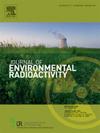Validation of a spatial model of background radiation using personal measurements in children
IF 1.9
3区 环境科学与生态学
Q3 ENVIRONMENTAL SCIENCES
引用次数: 0
Abstract
Background
Limited knowledge about the prediction accuracy of exposure models hinders the interpretation of results from epidemiological studies on childhood cancer risks associated with exposure to background gamma-radiation.
Objective
We aimed to validate a spatial exposure model that we recently developed for Switzerland.
Methods
We used individual exposure measurements conducted with D-Shuttle dosimeters by 149 children throughout the country. We ran linear regression models fitting the measured exposure against predictions from the newly developed model, and compared results with the predictions from an earlier model. We further used variograms to investigate the spatial correlation of estimation errors.
Results
The prediction accuracy of the newly developed exposure model was modest (R2 = 0.2), but better than the earlier model (R2 = 0.13). Prediction errors revealed weak spatial correlation.
Discussion
Although the new exposure model marks an improvement, the modest prediction accuracy and the remaining spatial correlation of errors show room for further improvement. Our study highlights the need for validation of exposure models for background gamma-radiation used in epidemiological studies.
使用儿童个人测量验证背景辐射空间模型。
背景:关于暴露模型预测准确性的有限知识阻碍了对与本底伽马辐射暴露相关的儿童癌症风险的流行病学研究结果的解释。目的:我们旨在验证我们最近为瑞士开发的空间暴露模型。方法:我们使用D-Shuttle剂量计对全国149名儿童进行了个体暴露测量。我们运行线性回归模型,拟合测量的暴露量与新开发模型的预测,并将结果与早期模型的预测进行比较。我们进一步使用变异函数来研究估计误差的空间相关性。结果:新建立的暴露模型预测准确度一般(R2 = 0.2),但优于原有模型(R2 = 0.13)。预测误差显示出较弱的空间相关性。讨论:虽然新的暴露模型标志着改进,但适度的预测精度和剩余的误差空间相关性显示出进一步改进的空间。我们的研究强调需要验证流行病学研究中使用的背景伽马辐射暴露模型。
本文章由计算机程序翻译,如有差异,请以英文原文为准。
求助全文
约1分钟内获得全文
求助全文
来源期刊

Journal of environmental radioactivity
环境科学-环境科学
CiteScore
4.70
自引率
13.00%
发文量
209
审稿时长
73 days
期刊介绍:
The Journal of Environmental Radioactivity provides a coherent international forum for publication of original research or review papers on any aspect of the occurrence of radioactivity in natural systems.
Relevant subject areas range from applications of environmental radionuclides as mechanistic or timescale tracers of natural processes to assessments of the radioecological or radiological effects of ambient radioactivity. Papers deal with naturally occurring nuclides or with those created and released by man through nuclear weapons manufacture and testing, energy production, fuel-cycle technology, etc. Reports on radioactivity in the oceans, sediments, rivers, lakes, groundwaters, soils, atmosphere and all divisions of the biosphere are welcomed, but these should not simply be of a monitoring nature unless the data are particularly innovative.
 求助内容:
求助内容: 应助结果提醒方式:
应助结果提醒方式:


